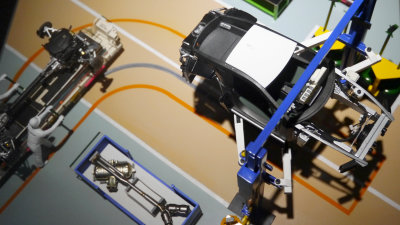I was curious about the flashy building 'Maishima Factory', which is quietly nestled on an artificial island, so I visited it.

Maishima, located in Konohana Ward, Osaka City, Osaka Prefecture, is an artificial island of approximately 220 hectares, most of which is occupied by a park called 'Maishima Sports Island,' which was built as part of the activities to attract the 2008 Summer Olympics. I will. Other than that, there are many corporate distribution bases and fruit and vegetable centers, but in one corner there is a building that can be mistaken for an amusement park. This building is a facility called 'Maishu Factory' and is a so-called garbage disposal site that incinerates garbage carried from all over Osaka City. It is said that you can tour not only the exterior but also the interior of the Maishu factory for free, so I actually went to see it.
Tour of the incinerator factory-Osaka Wide Area Environmental Facility Association
I came to Maishima in Konohana-ku, Osaka.

This area is an area where distribution centers and factories are lined up.
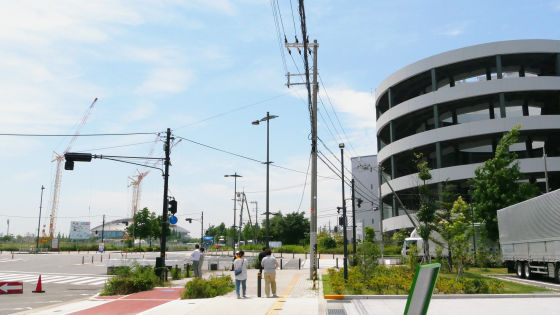
Suddenly, the Maishu Factory, which looks like an amusement park, appears in it.
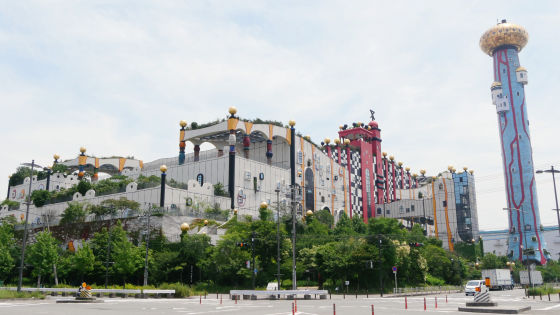
The Maishu Plant
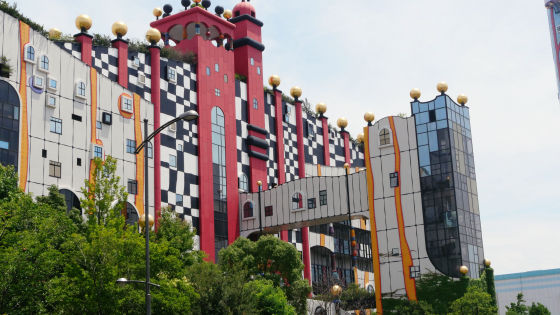
The identity of the huge tower is a chimney for the smoke generated when garbage is incinerated.

The project cost of the Maishu factory is about 60.9 billion yen, and the design fee by Mr. Hundertwasser is about 66 million yen. In addition, there are only two garbage incinerators in the world that Mr. Hundertwasser worked on, and one of them is in Osaka.

After taking a closer look at the exterior, this time we will visit the interior. For the tour, it is necessary to make a telephone reservation and fax the (PDF)

Colorful design up to the pillars. According to Mr. Hundertwasser's intention, each pillar has a different design.

Enter from the entrance on the 1st floor.

The interior of the building was decorated with a mosaic pattern.

If you tell the receptionist that you have made a reservation, the staff will guide you carefully. The corridor that I passed through when I was being guided was so fashionable that I couldn't think of it as a garbage incinerator.

I was guided to the large conference room.

A 20-minute movie was shown in the large conference room.

After watching the movie, the tour starts from the 5th floor where the large conference room is located. Even if you are alone, the staff will accompany you on the tour. The first thing I saw was a model of the Maishu factory. The Maishu Plant has an incinerator that processes general waste and a bulky waste disposal facility. There is also a facility that uses the steam generated during the incineration of garbage as renewable energy.

The space on the 5th floor was like a huge hall.

This is a facility called a 'garbage pit' that stores the collected garbage. A large amount of garbage is stored in a very deep space.

A crane equipped with a huge claw grabs the garbage and carries it to the input hopper connected to the incinerator.
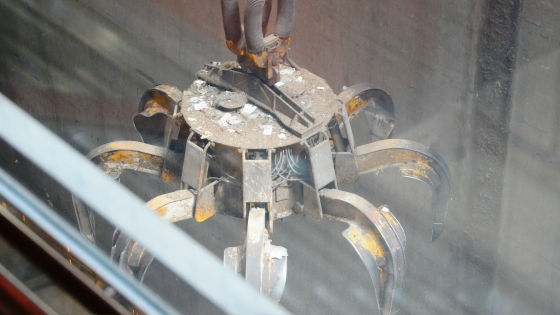
The amount of garbage that the crane lifts at one time is about 1 ton, which is 6 m when the claws spread.

A model of a crane claw was displayed near the window overlooking the trash pit. It is said that one claw weighs about 450 kg.

The crane is self-driving and is hung with four wires.

When you look straight down, your legs are shrugged to the depth.

After the tour on the 5th floor, we were guided to the 3rd floor.

The 3rd floor was decorated like a cave for a tour.

This large display uses animation to explain the equipment in the back. What is the equipment in the back ...

It is an incinerator. The other side of the red door is an incinerator, and when it is hot, the temperature around the door may rise to nearly 40 ° C.

I couldn't enter the incinerator, so the illustration explained the details of the incinerator. The incinerator is shaped like a conveyor belt tilted diagonally and is divided into three parts: a 'dry grate', a 'combustion grate', and a 'post-combustion grate'. The carried garbage is sent to the dry grate, dried, burned in the combustion grate, and then completely ashed in the post-combustion grate. The air used for combustion is the air containing the odor in the garbage pit, and the odor is thermally decomposed by combustion, and measures are taken to prevent the odor of garbage from leaking out of the facility. In addition, the ash generated after burning garbage is cooled and then sent to the 'ash pit' where it is transported by truck to the landfill site.

This is the garbage that was actually brought in and dried at 85 ° C for 75 hours.

After being incinerated, garbage will be incinerated ash that is one-fifth by weight and one-fifteenth to one-twentieth by volume.

Next, we visited the ash crane and ash pit.

Like the incinerator, it cannot be put inside, but this is a place to store the incinerator ash, and the incinerator ash is loaded onto the truck by an ash crane and carried to the landfill.

The next guide was 'Steam Turbine Generator'. As mentioned earlier, the Maishu Plant uses the steam generated during the incineration of garbage to generate electricity in the plant, and transmits the surplus electricity to the electric power company. It is the steam turbine generator that produces electricity from the steam.

However, there is a large facility described as a steam turbine in a large space.

Inside the green box labeled Steam Turbine is a huge turbine. The power of steam is used to rotate the turbine to generate electricity.

The amount of electricity generated in real time at the Maishu Plant is 8250kW. 8250kW is equivalent to 16,430 500W household vacuum cleaners.

The Maishu Plant generates about 1000kWh per ton of garbage, which is one of the top-class garbage incinerators in Japan.

This is the place where garbage trucks carry garbage. Many garbage trucks were coming and going.

When you put garbage on the other side of the blue door, the bottom opens and the garbage falls into the garbage pit. However, for safety, it seems that the bottom will not open unless the blue door is closed and safety is confirmed.

Next came the 'Oversized Garbage Pit'

This is a large pit that stores only oversized garbage. If you look directly below, you will find oversized garbage of various sizes.

When I was looking at it, oversized garbage was just carried.

A large amount of mattresses were brought in, and they suddenly fell into the oversized trash pit.

Oversized garbage is divided into non-combustible and flammable oversized garbage, and the non-flammable oversized garbage is stored in the pit and then crushed into small pieces of about 150 mm or less by a 'rotary crusher'. In addition, flammable bulky waste is crushed into small pieces of about 400 mm or less by a machine called 'low-speed rotary shear crusher'. Below is an illustration of a rotary crusher, depicting a hammer that crushes incombustible bulky waste.

This hammer rotates at a speed of about 152 km / h to crush non-combustible bulky garbage. When an iron block rotates at 152km / h, you can imagine that no matter how large the bulky garbage is, it will shatter.

Finally, we visited the courtyard of the Maishu factory. The Maishu Factory is planted with lawns and trees everywhere as a symbol of harmony with nature.

Looking at the equipment inside the building and then looking at the flashy appearance makes me feel strange about the gap.

Inside the huge tower are two chimneys that connect two incinerators, and there is a spiral staircase inside. The golden part at the top does not have any special function, it is a part of the decoration.

This is the end of the tour. It took about 1 hour and 30 minutes in total including the movie that was screened.

The appearance of the Maishu Factory tends to be noticeable, but the equipment inside is as interesting as the appearance. In addition, the staff will always accompany you and will politely tell you when you ask a question. The nearby Universal Studios Japan is also a fun place, but the Maishima Factory can be visited for free, so if you are interested, you may want to visit.

Related Posts:


